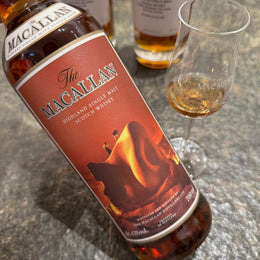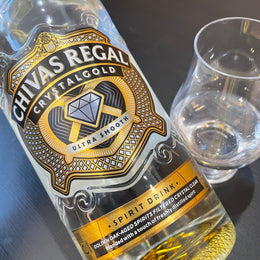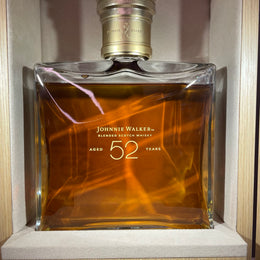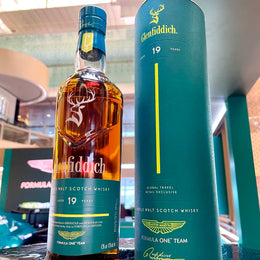
Every year, Bourbon fans try their luck at hunting down or winning by ballot one of a bottle from Bourbon's most sought after set of releases - that's the Buffalo Trace Antique Collection. Talk about Hunger Games.
The Buffalo Trace Antique Collection (or BTAC for short) comprises of a standard issue of five labels - the 17 Year Old Eagle Rare, the George T. Stagg Bourbon, the 18 Year Old Sazerac Rye, the Thomas H. Handy Sazerac Rye and of course, the William Larue Weller Wheated Bourbon.


The Buffalo Trace Antique Collection. (Image Source: Robb Report)
These labels are made from three (out of four Buffalo Trace Mashbills) - the George T. Stagg and the 17 Year Old Eagle Rare comes from the low-rye Mashbill #1, while the 18 Year Old Sazerac Rye and Thomas H. Handy Sazerac Rye both from the Rye Mashbill, and then there's William Larue Weller which comes from the Wheated Mashbill.
And much like how every parent says they don't have a favorite child - y'know they have a favorite child. For the BTAC, that's consistently either the George T. Stagg or the William Larue Weller (or W. L. Weller, or WLW).
That's because George T. Stagg is considered to be the biggest powerhouse of the lot - it punches in at the highest proof of the BTAC set and is considered overproof. Basically the flavor bomb of the lot.

Buffalo Trace's various Mashbills. (Image Source: Bourbonr)
W. L. Weller on the other hand stands on its own for coming singularly from Buffalo Trace's Wheated Mashbill, which guess what - is responsible for only the Weller label and also arguably the most sought after of all Bourbons, the Pappy Van Winkle label. There aren't a whole lot of wheated Bourbons out there. And for the record, at just shy of 13 years old, the W. L. Weller is also the second youngest on the BTAC lot - but depending on your philosophy about whether you see life as half full or half empty, is also the oldest (and the youngest, as is the only) wheated Bourbon of the lot.
When you share a lot with the most sought after Bourbon label, you don't need such a high proof to command as much attention. In fact, since the Pappy brand came to be produced by Buffalo Trace, having run dry its stock from the no longer commercially operating Stitzel-Weller Distillery, it can only mean that Pappy bottles are simply top picks from what would otherwise be Weller barrels. So being cut from that same cloth is always going to make the W. L. Weller highly popular.

Now, the man behind the label - William Larue Weller himself, was a legend in the Bourbon-making scene for pioneering the use of wheat in his Bourbons. While all Bourbon has to use 51% corn in its mashbill, Weller swapped the next most used ingredient from rye to wheat - thereby creating the Wheated Mashbill.
This was happening back in the mid-1800's. Subsequently Weller's distribution company came to be acquired by a Julian "Pappy" Van Winkle Sr., who had actually got his start as a salesman for the company. Under Pappy, the distributor was merged with the A. Ph. Stitzel Distillery in Louisville, Kentucky, to create the Stitzel-Weller Distillery. Shortly thereafter, Prohibition hit in the 1920s, where nonetheless the company was still able to produce whisky for "medicinal purposes" for the government.
Hence, it's not unsurprising that the Weller and Pappy labels share the same mashbill considering they go wayback and have a much intertwined history.

The full Weller lineup. (Image Source: The Bourbon Review)
The Weller lineup itself a total of 7 expressions, with the W. L. Weller sitting as the crown jewel. Anything on top of that would be the Pappy stuff.
So today, I have the massive fortune to try the 2016 release of the W. L. Weller, bottled at 135.4 Proof. Some other fun facts are that the angel's share for the WLW typically runs upwards of 60%.
Let's go!
William Larue Weller 2016 Release, 135.4 Proof (67.7% ABV) - Review

Tasting Notes
Color: Brown
Aroma: It starts off very dense, deep and of darker notes - burnt brown sugar, caramelised figs, prunes, peaches, poached apples and apple pie stuffing, baking spices, treacle, Graham crackers, pecan pie. Slightly brighter but also nonetheless rich is a cream custard note - with that sort of oily buttery texture, punctuated with a grittiness of coffee grounds.
And at the same time there's that sour and tart cherry candy or Twizzler candy, a sort of red cherry and licorice note. Continuing on the richer, darker notes are raisin fruitcake, mocha, leather, tobacco, anise, and a little bit of that old woody mustiness - think an attic. It's light spicy in a sort of allspice manner, with a dash of menthol.
Taste: Hefty here - with lots of dark brown sugar, cinnamon rolls, vanilla pods, fruit jam - blackberries, figs, raisins. Still that tart Cherry Twizzler candy, as well as green apple and slightly tart maple syrup. And then continues like its aromas onto darker notes of dark chocolate, mocha, baking spices, treacle, butterscotch, cream custard.
There's this char - burnt brown sugar, overdone toast, marmite, charred oak, burnt rubber, earthy soil - which leads into a more umami, bitter, drying oaky astringency, distinctive but not overpowering. There are also notes of chocolate-coated orangettes, ginger candy, tobacco, leather, fruitcake.
Finish: It goes on for quite some time - a really long, warming finish. Very nice, honestly. After some time, the sweet brown sugar, rich dark cacao bits and tart cherries fades into more oakiness, coming with that bitterness and almost has a sort of grittiness again of coffee grounds and also aromatic tobacco.

My Thoughts
Might be abit of a hot take here, but being far removed from America, the land of Bourbon-mania (and I suppose being closer to other manias such as Japanese whisky fever), I would say that this isn't particularly complex, albeit very consistent from start to finish. What you got on the aromas pretty much followed through.
What I was impressed about is that on the palate, the body of this Bourbon really held up - it was thick and creamy and yes, alittle hot, but was enough to give a whole lot of oomph and was very flavor heavy. There's an oft saying that you can't judge a Bourbon by its nose - lots of Bourbons sniff great - brown sugar, baked pastries, what's not to love? The real test is in whether the body holds up and for me that's two-folds - the weight of the body and the flavor on the palate. I think there's alot of emphasis on the latter, but without the former the delivery just falls short.
Here, the body truly delivered - so count me a happy man. From first impressions on the nose to the delivery and execution on the palate and the leftover on the finish - this was consistent through and through. The flavors are very much lovable as well, I liked that the sourness of the cherry and the bitterness of the oak added to the experience rather than distracted (when it gets too overwhelming).
My Rating |
😐Ehhh it's okay. It's a solid Bourbon, that's for sure. Not the most complex, but it does consistently deliver from start to finish. What impressed me most was how its palate really held up in most mouthfeel and flavor. Would I buy a bottle? No. (You can thank me for recusing myself) Would I try it as a dram? Sure! Once. Alittle overrated - to not fault of Buffalo Trace. |
A really, solid Bourbon, to say the least. In America, this would be a moot point in the eyes of most drinkers. And kudos to Buffalo Trace, for some reason it's not fallen prey to the whole "it's overhyped!" critique that is often levied at anything topshelf. For good reason - they've largely delivered.
But I suppose the grand question is would I pay US$1,500 for this, much less the Hunger Games I'd have to put myself through to possibly stand a chance at getting a bottle - pass. Hard pass.
Would I try it as a dram? For sure! Once. I feel there are better things out there for a fraction of the price and of more value.
You can find William Larue Weller's with most major US specialist stores. Internationally, The Whisky Exchange and Master of Malt carry them. Otherwise, there's always the auctions at Whisky Auctioneer.
Kanpai!

@111hotpot







